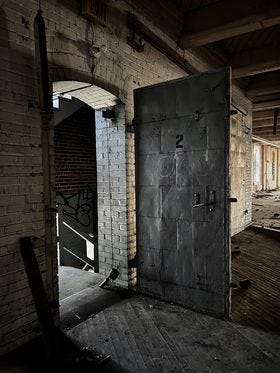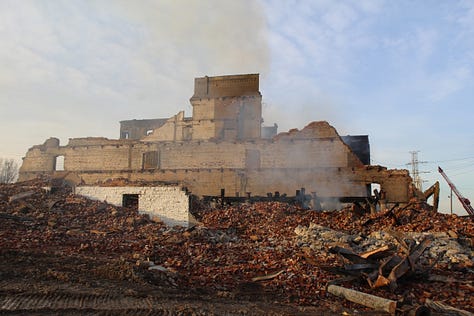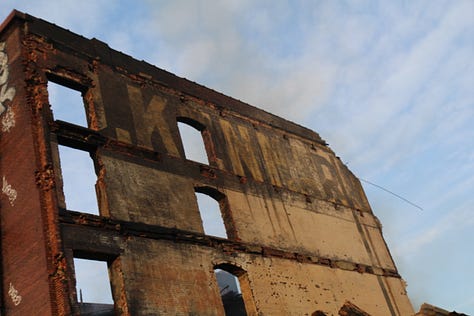Not Just Another Abandoned Warehouse
The story of Shapleigh Hardware's Warehouse No. 3 and its fiery demise
Welcome to another Unseen St. Louis. Once again, I hadn’t planned on writing a new article today, but on the way to City Museum for a tour for Unseen STL History Adventures, I noticed a significant amount of smoke. After leaving City Museum, we checked it out, and sure enough, another old warehouse was going up in smoke. This is its story.
On the morning of February 3rd, the city of St. Louis witnessed another loss of its architectural and industrial heritage. The Shapleigh Hardware Warehouse No. 3, a substantial 5-6 story structure spanning an entire city block at 1st and O’Fallon Streets (1230 N. 2nd), became engulfed in a devastating 4-alarm fire. So far, there’s no word on the cause, and so far, it appears there were no injuries, which, if it remains true, is good news. But the building is likely a total loss.
This tragedy strikingly mirrors the fate of the Beck and Corbitt warehouse (directly across the railroad tracks), which met a similar end in October 2022.
Once celebrated as an industrial titan, St. Louis is dotted with numerous 19th- and early 20th-century buildings that testify to its rich history. However, many of these structures lie abandoned, falling prey to the elements and neglect, and sadly, many end up destroyed by fire. Shapleigh Hardware’s Warehouse No. 3 is the latest in this series.
It's always a somber task to write about these buildings posthumously, as they deserve more than to be remembered solely for their tragic ends. Even so, it feels appropriate to give them a memorial so that they don’t get written off as “just another abandoned warehouse.” In honoring Warehouse No. 3, let’s also take a look back at a company that, for a while, epitomized everything that made St. Louis such an important manufacturing city.
Feb 4th update: according to a local report, fire officials don’t know the cause of the fire, though it appears suspicious. At any rate, it looks like it will be torn down as soon as the fire is completely out due to “emergency purposes” (which could be its proximity to an active railway line.)
Feb. 8th update: the building was still smoldering, but the wrecking crew has been hard at work bringing down the remaining walls of the structure. I was also interviewed today by KMOV-TV, along with Tim Tucker and Cara Spencer, about the building and the overall issue of historic preservation for these old buildings.
Feb. 9th update: I honestly thought this story would be over, but today was possibly the most “exciting” day yet. Apparently, the demolition crew knocked a wall into a high-voltage power line, disrupting power for a portion of Downtown.


And then, when I went looking for more news on that development, I discovered that the cause of the fire is now being investigated by the ATF after an anonymous tip. I welcome that investigation because it seems like too many of these buildings are burning down without any real answers as to why.
Who was A. F. Shapleigh?
Augustus Frederick Shapleigh, born in 1810 in Portsmouth, New Hampshire, was the son of Captain Richard Shapleigh, who tragically died at sea. With a strong inclination towards the sea, young Shapleigh briefly embarked on a seafaring journey himself before his mother persuaded him to pursue a safer path. At the age of fourteen, he started working for a hardware firm, Rogers Brothers and Company in Philadelphia, where he rapidly rose through the ranks to become a junior partner.
Shapleigh's relocation to St. Louis in 1843 marked a pivotal moment in his career and the city's commercial history. He established a hardware store for Rogers, Field & Company, which was later renamed Rogers, Shapleigh & Company. This venture, leveraging St. Louis's strategic position as a gateway to the West, soon flourished, benefiting from the city's burgeoning river trade and the gold rush era.
Beyond his business acumen, Shapleigh had diverse interests, including banking, insurance, and mining. He played a significant role in various St. Louis business enterprises, becoming a director at the Merchant's National Bank and president of the Phoenix Insurance Company. His legacy extended beyond his death in 1902, with his descendants continuing to play roles in hardware sales, philanthropy, and medicine.
The Shapleigh Hardware Company
The Shapleigh Hardware Company was integral to the development of St. Louis, a city that became a hub of industry and commerce during the 19th century. Shapleigh's entrepreneurial vision was evident in the firm's early adoption of strategies like publishing hardware catalogs and employing traveling salesmen, a novel concept at the time.

Unlike most hardware stores that focused on retail business, Shapleigh Hardware provided hardware wholesale, which, according to a 1909 article in the Post-Dispatch, was a novel approach. The company’s catalog included everything from woodworking equipment to meat grinders to knives—as the illustration above indicates, they were quite a diversified company. They capitalized on the 1848 gold rush by selling various hardware, such as the iconic pick axe, to prospectors.
Following the death of Rogers in 1847, the company underwent several name changes and reorganizations. Notably, in 1864, the company introduced the Diamond Edge trademark, a symbol of quality in the hardware world. The firm's importance in St. Louis's commercial landscape was further emphasized by its involvement in key events like the 1904 World's Fair.
The company continued to grow and diversify, absorbing competitors and expanding its product range. In 1901, it was reorganized as the Norvell-Shapleigh Hardware Company under the presidency of Saunders Norvell.
The company shuttered in January 1960, citing high labor costs and changing industry trends.
Warehouse No. 3
Norvell-Shapleigh Hardware Company Warehouse No. 3, a significant piece of industrial architecture in St. Louis, was constructed between 1904 and 1906. Designed by Isaac Taylor and built by the Kellermann Construction Company, this warehouse exemplified the industrial growth and architectural advancements of the early 20th century.
This building—or more accurately, as we discovered as the fire peeled away the outer walls, several buildings that appeared as one structure from outside—housed the Norvell-Shapleigh warehouse as well as Kennard & Sons Rug Company.

The warehouse was a testament to the Shapleigh Hardware Company's success and expansion. After A.F. Shapleigh's retirement in 1900 and the subsequent rebranding to Norvell-Shapleigh Hardware Company in 1901, the construction of Warehouse No. 3 symbolized the company's growth and modernization. The building prominently featured the "Diamond Edge" trademark, a hallmark of the company's commitment to quality, which became widely recognized in the hardware industry.
Below are some interior images of the warehouse from 2023, taken by Amanda Randazzo and used with permission:









In 1940, Shapleigh Hardware purchased Simmons Hardware Co. and moved its operations from the three buildings pictured in the advertisement above to the Simmons building at 900 Spruce Street. After that, the warehouse building underwent numerous changes in ownership and function until its closure in the early 1960s.
From there, the story is harder to piece together. In a 2017 image from Google Maps, it appeared the building was undergoing renovations, but I’m not sure if anyone was using the building after that point. According to a St. Louis parcel search, there are two owners for the address of 1230 N. 2nd St., which is the address on the corner of the building: Eubanks Storage LLC and Patricia Ahrens, Second St. Investments LLC.
The firefighters noted that fire suppression was more difficult in some parts of the building due to large quantities of paper.
For more information on this building and the surrounding area, check out the National Register of Historic Places Registration Form for this area filed by Landmarks Association in 2002, below:
After the fire
Here are a few photos I took of the Shapleigh Warehouse around 4:30 pm on Saturday, approximately 10 hours after the fire started. The walls had already collapsed to the south on the Ashley St. side, and the fire was still not under control.
Photos from Feb. 6th and 8th:
















As always, thanks for your support. Unseen St. Louis is always free to read, but if you like what I’m doing, consider a paid subscription.
And please share this article with others who may appreciate it.
Sources:
Augustus Shapleigh, Wikipedia.
Brief History of The Shapleigh Hardware Company, from the Archives of The Winchester * Keen Kutter* Diamond Edge Chronicles Volume 1, Number 3 & 4, March 1997.
4-alarm fire burns warehouse in downtown St. Louis, KSDK, 3 February 2024.
Shapleigh Hardware Company Saint Louis.
Jeannette Cooperman, The Shapleigh Family: Captains of Industry, St. Louis Magazine, Aug. 20, 2015.
Chris Naffziger, Norvell Shapleigh Hardware Warehouse, Saint Louis Patina, Nov. 20, 2015.
Robby Virus, Norvell-Shapleigh Hardware Company, St. Louis, MO, Flickr, April 13, 2016.
St. Louis Post-Dispatch:
18 Apr 1901
20 June 1909
06 Jan 1960













Some pictures from Saturday afternoon https://www.threads.net/@stevestruemph/post/C25f5M6PSC6/?igshid=NTc4MTIwNjQ2YQ==
Thank you for writing this